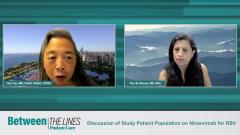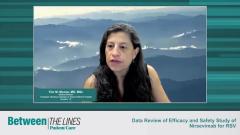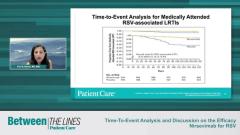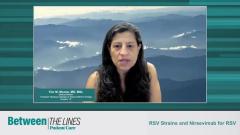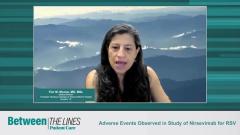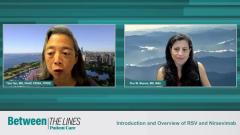
Discussion of Study Patient Population on Nirsevimab for RSV
Flor M. Munoz, MD, MSc, and Tina Tan, MD, FAAP, FIDSA, FPIDS, discuss the patient population of the safety and efficacy study on nirsevimab for Respiratory Syncytial Virus (RSV).
Episodes in this series

Transcript
Tina Tan, MD, FAAP, FIDSA, FPIDS: When you look at the prespecified subgroup analyses of the primary endpoints, they were stratified by a number of different factors, as we talked about, such as the hemisphere where they lived, the age of randomization, the sex, the race, the weight, and the gestational age. And we know that the follow-up in this study was actually quite good: 98% of the enrolled patients completed follow-up up to 150 days, and 92% of the participants completed follow-up up to almost a year after receiving the injection of nirsevimab or placebo. This is a very long-term follow-up for the study. I think what’s also really important is that 86% of the enrolled infants were healthy infants who were born at term. The study really was looking at the efficacy and safety of nirsevimab in healthy term infants. The median age of the study population was about 2 and a half months, but obviously there was a big range of infants who were enrolled. This next slide looks at the baseline patient characteristics across all the different groups, looking at age, gestational age, and whether they received nirsevimab or placebo. The following table looks at the baseline patient characteristics, looking at the weight as well as the sex of the infants. The graphs that you see here are looking at the race and ethnicity, and not surprisingly, the majority of the infants in both groups were of White race. But there were other races that were included in the study, including Black, Asian, Native Hawaiian, Pacific Islanders, and other races. I think that is good in that there was some diversity in the patients who were enrolled in the study, even though over 50% of them in both groups were White. In your opinion, [Dr Munoz], is this patient population that was enrolled in the study reflective of the general population at risk for RSV?
Flor M. Munoz, MD, MSc: Yes, absolutely. What you can see, again, the focus here is on the term babies, which we know are the ones who have the majority of the cases of RSV every winter. The study did look at late-preterm [infants], so those will be those babies who are born at least 35 weeks of gestation, but under 37 weeks, [because] after that is term. I think in that sense, this study is particularly addressing this population that has not, again, been able to be protected before through any interventions, and that suffers a majority of the disease. We know that RSV also does not discriminate, so it affects all races, all geographies. We do see a variability in how the virus circulates, and [this study looks at the] Southern and Northern hemispheres. So we have opposite seasons, right? When we have our wintertime in RSV, it’s the summer in the Southern hemisphere, but then it turns over, and we have our summer, and they have RSV in the winter. So it circulates year-round, and it’s good, again, that this study did look at populations throughout the world and populations of different race, ethnicity. I think that it’s always very difficult to have a very balanced race [and] ethnicity distribution, but the fact that nearly 50% of the participants were non-White is actually a very good point as well, because we do know that some populations that are of this group, race, ethnicity, either Black or Hispanic, or some other subgroups, Asian and so on, especially some information has become available regarding American Indian and Alaska Native [populations], who do have a high risk sometimes for respiratory infections in general. We know that about influenza. RSV is also an important pathogen in these populations, and these are groups that need to be represented so that they can also benefit from the protection of these studies.
Tina Tan, MD, FAAP, FIDSA, FPIDS: I definitely agree with you, because these patients sometimes are at higher risk of contracting RSV, so if we’re able to give them protection, then we can actually decrease the rate of complications and hospitalizations that occur in these populations.
Transcript is AI-generated and edited for clarity.
Newsletter
Enhance your clinical practice with the Patient Care newsletter, offering the latest evidence-based guidelines, diagnostic insights, and treatment strategies for primary care physicians.



